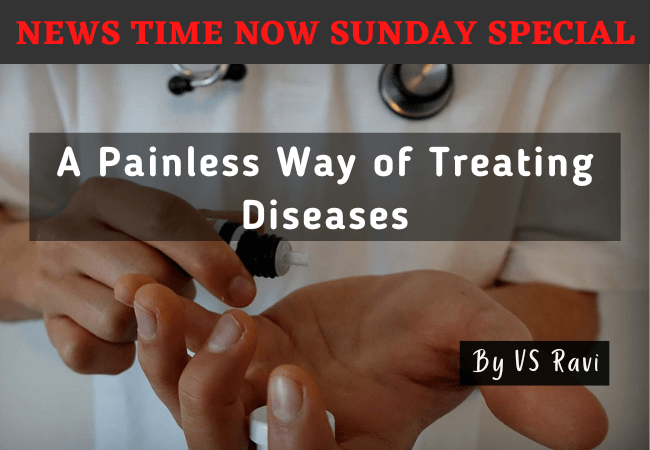I wish no living thing to suffer pain.
– SHELLEY
All of us have sometime or the other experienced a twinge of guilt on hearing a child’s heart-rending screams while compelling him to bare his tender arm to receive the prick of a needle, for a doctor to administer a medicine (or vaccine) or take a blood sample. In fact without exception, we all regard injections as inefficient or painful ways of administering drugs. For the first time, however, in medical history a new generation of devices for dispensing potent drugs painlessly and effectively seem to be in sight, e.g.
(1) plastic-shrouded capsules and tablets that will soon replace vaccinations, insulin and some anti-cancer drugs thus eliminating the need for shots;
(2) surgeons can emplace paper-thin sheets containing anti-cancer agents very near tumours in the body to accelerate chemotherapy possibly alleviating many of its adverse side- effects;
(3) tiny spheres carrying drug that tackle disease will be injected into specific areas of diseased tissues where they will work silently for days or weeks providing painless treatment;
(4) a very light package of electronic pumps will send a programmed flow of up to four cancer-fighting drugs to attack obstinate tumours.
By tradition and convention drugs have had to be injected into the bloodstream with the needle rather than swallowed. This is because the enzymes in the stomach and small intestine would destroy these drugs before they reach their targets. (Penicillin is a case in point. This rather powerful antibiotic if swallowed loses most of its potency due to interaction with the acids and other juices in the stomach. Hence to be effective, extremely large doses have to be taken orally for a long time. On the other hand when injected into the blood stream directly the full benefit of the doses administered can be had by the body. We are of course not considering those rare cases of severe shock resulting from allergy to penicillin! But patients may soon be offered the convenience and ease of pills or tablets that are as effective as injections and are also painless, a factor relevant when dealing with children and older persons.
This breakthrough has been made possible by the development of special plastic coating by biochemist Murray Saffran of the Medical College of Ohio in Toledo, United States. This plastic coating will allow drugs to be swallowed rather than injected. Enzymes of stomach and small intestine cannot digest the plastic (which will incidentally not harm the delicate lining of the stomach); instead, it will be degraded by the bacteria found only in the large intestine – the unleashed drugs will then diffuse and be absorbed through the intestinal wall into the blood stream.
Researchers feel that any drug that has now to be only injected to be effective is a potential candidate for this plastic coating, as has already been proved in some experiments with animals.
Another reason to set aside the needle and syringe is the development of new biodegradable polymer sheet impregnated with cancer- fighting agents. To use this sheet surgeons would have to first remove as much of a tumour as possible and then implant this special sheet near the site of the tumour. The drug would then slowly spread to act directly on any remaining diseased cells. Since the sheet effectively blankets a tumour with drugs, dumping chemotherapeutic medicine into the bloodstream will no longer be necessary. This would automatically eliminate the nasty side-effects of chemotherapy and the drug can go straight to work on the tumour. According to one researcher who is developing the sheet in the United States the polymer is particularly suited to brain tumours. He feels blood-borne drugs cannot easily get into the brain; the sheets will be able to expose tumour to drugs in concentrations much higher than would otherwise be possible.
The new microcapsule method also puts the drug close to the disease. Microcapsules are tiny spheres, made from molecules found naturally in the body and are similar to drug-carrying liposomes—microscopic bubbles made of lipids, the molecular components of cell membranes. Both types of microsphere can be manufactured in different sizes (depending upon the targeted tissue) and can contain a variety of drugs. And both can be injected into most diseased tissues.
Because the microspheres break down slowly, the drugs they carry spread into the diseased tissue over a long period reducing the number of injections needed. The technique also limits the toxic effects of drugs such as those used to battle cancer drugs that slowly eat into the physical texture of the scalp, brain and body It may prove effective in the treatment of numerous other diseases including arthritis, diabetes and heart disease. As in the case of plastic coated pills and polymer sheets, microcapsule technology would require more refinement before being used routinely in hospitals.
The ability of doctors to give pills/tablets that will painlessly take the drug directly to the target site without, at the same time, inducing any side-effects would represent a major breakthrough in the treatment and control of disease. It would also prevent future generations especially the old, the infirm and the young from experiencing pain due to injections, which at present are the only effective method of delivering drugs directly into the blood stream.


















































